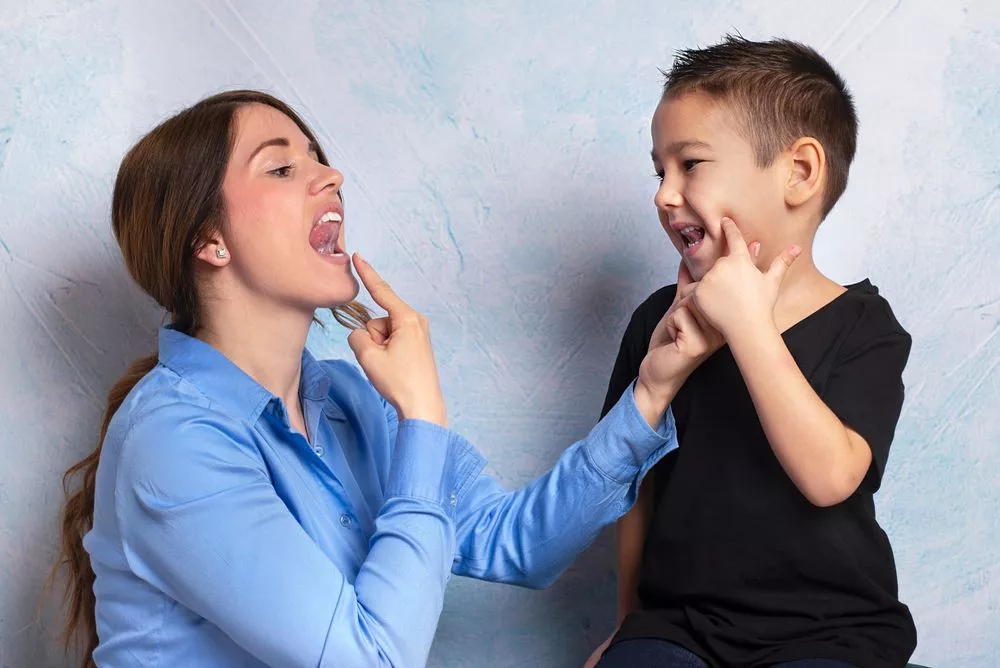No products in the basket.
Introduction
There are plenty of chances for those looking to enter the speech and language therapy field to help those with speech and language challenges. As a speech and language therapist, you must identify and address these challenges to help clients achieve their goals.
It is your role to assist clients of all ages to overcome speech and language difficulties. This can range from teaching youngsters how to pronounce specific phrases correctly to assisting people with aphasia in regaining their speaking capacity.
Whether you are a newly qualified speech and language therapist or an experienced one seeking speech and language therapy employment, it is critical to learn how to successfully recognize and treat these difficulties in your clients.
This blog post will discuss the basics of speech and language therapy jobs and how to identify and address speech and language challenges.
What is Speech and Language Therapy?
Speech and language therapy is a healthcare intervention that assists people with communication and swallowing challenges. Speech and language therapists examine and treat speech and language problems in persons of all ages, from newborns to adults.
A speech and language therapist is a healthcare practitioner who is highly trained to recognize, diagnose, and treat people who have trouble communicating or swallowing. They may also advise assisting caregivers on effectively assisting the individual with speech or swallowing challenges.
A speech and language therapy assistant works closely with a speech and language therapist, assisting with evaluations, treatments, and other clinical analyse.
Speech and language therapists analyze an individual’s capacity to communicate safely and effectively using some approaches and instruments. Moreover,the speech and language therapist’s tactics are determined by the individual’s age and difficulty level.
The therapist can create an intervention plan based on the evaluation, which may involve verbal, writing, and nonverbal communication strategies. The intervention plan aims to help the individual communicate more effectively and efficiently.
It is critical to remember that speech and language therapy is about more than simply teaching new skills; it is about building connections between the speech and language therapist, the client, and the family/caregiver to foster trust and understanding. This method can help you improve your general communication abilities.
Speech and language therapy may include one-on-one sessions with the client, group sessions, or virtual sessions using video conferencing technology. So, it is critical to note that speech and language therapy should be personalized to each client’s requirements, considering their interests, goals, talents, and preferences.
Understanding Speech and Language Therapy Disorders

A speech disorder is when a person has difficulty making or forming the spoken sounds required to communicate with others. This might make the child’s and adult’s speech challenging to understand.
The following are some examples of common speech disorders:
- Articulation disorders
- Phonological disorders
- Disfluency
- Voice disorders or resonance disorders
Language difficulties in children are different from speech issues. Someone with a language impairment has trouble with the following:
- Communicating their meaning or message to others (expressive language)
- Understanding what others are saying (receptive language)
- Speech and Language Disorders in Children
Speech and language are vital in everyday life, and humans typically acquire these skills spontaneously from infancy until youth. Occasionally a youngster does not develop speech and language as predicted or has difficulty communicating and learning. When this happens, a child may have a speech or language issue.
- Speech and Language Disorders in Adults
Speech and language impairments can develop gradually in adults, but they can also emerge suddenly, as in the case of a stroke. Disorders might include a loss of capacity to convey or comprehend language, difficulties making specific sounds or phrases (for example, slurring), and changes in the rhythm or pace of speech. Swallowing issues can sometimes be a symptom of a disorder.
-
Causes:
One of the basic ways we communicate with others around us is through speech. It emerges independently, among other signals of normal growth and development. Speech and language therapy disorders are widespread in preschool-aged children.
Disfluencies are conditions where a person repeatedly repeats a sound, word, or phrase. The most significant disfluency is stuttering. So, it might be caused by the following:
- Genetic abnormalities
- Emotional stress
- Any trauma to the brain or infection
Other family members may develop articulation and phonological difficulties. Also, other factors include:
- Issues with the form or shape of the muscles and bones required to produce speaking sounds. Cleft palate and teeth issues are examples of such modifications.
- Damage to sections of the brain or nerves that govern how muscles work together to produce speech (as in cerebral palsy).
- Loss of hearing.
Issues with air passage from the lungs via the vocal cords, throat, nose, mouth, and lips cause voice disorders. A voice problem might be caused by the following:
- Acid from the stomach moving upward (GERD)
- Cancer of the throat
- Cleft palate or other issues with the palate
- Conditions that damage the nerves that supply the muscles of the vocal cords
- Laryngeal webs or clefts (a birth defect in which a thin layer of tissue is between the vocal cords)
- Noncancerous growths (polyps, nodules, cysts, granulomas, papillomas, or ulcers) on the vocal cords
- Overuse the vocal cords by screaming, constantly clearing the throat, or singing.
- Symptoms of speech and language therapy:
Disfluency –
The most common form of dysfluency is stuttering. Among the symptoms of disfluency are:
- Adding (interjecting) more sounds or phrases
- Repetition of noises, words, or portions of words or phrases after the age of four
- Making words longer
- Pausing during a sentence or words, often with the lips together
- Tension in the voice or sounds
- Frustration with attempts to communicate
- Head jerking while talking
- Eye blinking while talking
- Embarrassment with speech
Phonological disorder –
The youngster only employs some or all of the anticipated speech sounds to make words.
- A word’s last or initial sound (usually a consonant) may be eliminated or modified.
- In other words, the youngster may have no difficulty pronouncing the same sound (a child may say “boo” for “book” and “pi” for “pig” but may have no problem saying “key).
Voice disorders –
Other speech issues include:
- Hoarseness or raspiness to the voice
- Voice may break in or out
- The pitch of the voice may change suddenly
- The voice may be too loud or too soft
- The person may run out of air during a sentence
Treatment Techniques for Speech and Language Therapy
Milder kinds of speech impairments in children may be outgrown. Treatment will be determined by the severity of the speech issue and its underlying cause. Speech and language therapy may benefit more severe symptoms or persistent speech issues.
During speech and language therapy, the therapist may teach your kid how to make particular noises with their tongue. Speech and language therapists employ various strategies to address speech and language issues. Such strategies include modelling, imitation, repetition, and visual assistance.
Modeling is a strategy speech and language therapists use to teach new words or sound patterns. This can be accomplished by vocal repetition or physically showing the words or sounds. Imitation is a strategy to get people to repeat what they have heard.
Repetition is another approach to guarantee that the individual has acquired and kept the new words or sound patterns. Visual aids such as drawings or hand gestures are frequently utilized to promote learning.
Storytelling, group dialogues, and role-playing can also be used in speech and language therapy. These activities are designed to assist the individual to acquire confidence in verbal communication.
Speech and language therapy is an effective treatment for speech and language disorders. Therapists can successfully assist individuals in overcoming their obstacles and accomplishing their communication objectives by employing proper therapy approaches.
Speech and language therapy is best delivered individually, according to each individual’s specific requirements. When seeking a speech-language pathologist, seek someone who has worked with clients with comparable speech and language issues.
The Importance of Early Intervention in Speech and Language Therapy
Early intervention is critical in speech and language therapy. Early intervention for speech and language therapy entails starting therapy when a child is still young and staying consistent with the intervention. The sooner a speech and language therapist can begin working with a kid, the better the outcome.
Speech and language therapy assistant employment can help enhance the time a therapist can spend with each particular patient, allowing the caregiver to get even more early intervention.
Early intervention in speech and language therapy can help children learn to communicate better, process language faster, and build social skills. It also helps prevent further delay and assists the child in developing higher-level skills.
Speech and language therapy assistant jobs can provide extra hands-on support for these young patients as they work through their therapy sessions. By providing an extra layer of support, these assistant roles can help ensure that patients are receiving quality early intervention.
According to research, children who receive early speech and language therapy intervention make better progress than those who do not. This is because early intervention enables assistance at the appropriate timing and intensity for each child’s requirements.
Early intervention for speech and language therapy also aids in the prevention or reduction of the severity of diseases such as stuttering and autism.
Early speech and language therapy intervention is essential in helping young patients reach their potential. By finding a qualified speech and language therapist and supporting them with resources such as speech and language therapy assistant jobs, families can ensure that their child is receiving the necessary early intervention to achieve positive outcomes.
Tips for Communicating and Engaging with Children with Speech and Language Challenges
- Speak clearly and at a natural pace
- Use simple and age-appropriate language
- Repeat and rephrase if necessary
- Use gestures and nonverbal cues to supplement language
- Provide positive reinforcement for communication attempts
- Encourage the use of alternative forms of communication, such as sign language or picture cards
- Provide opportunities for social interactions and practice with peers
- Avoid correcting or criticizing language errors, and focus on understanding
- Be patient and encouraging
- Consult with a speech-language pathologist for more specific strategies and individualized support.
Supporting Bilingual and Multilingual Children with Speech and Language Challenges
- Provide language-specific support: Use the child’s primary language when providing instruction and support.
- Encourage the use of both languages: Provide opportunities for the child to use and practice both languages.
- Assess language proficiency: Assess the child’s proficiency in both languages to determine if there are any language-specific challenges.
- Use bilingual resources: Use bilingual books, games, and other resources to support language development.
- Consult with a bilingual speech-language pathologist: A bilingual speech-language pathologist can provide specialized support for bilingual children.
- Collaborate with the family: Work closely with the child’s family to understand the child’s language background and incorporate the family’s cultural and linguistic resources into therapy.
- Be aware of potential cultural differences: Be aware of potential cultural differences in communication styles and make necessary adjustments.
- Be patient: Learning two or more languages can be challenging, so be patient and encouraging as the child develops their language skills.
- Don’t assume one language is stronger: Children develop at different rates in each language, so don’t assume one language is stronger or weaker.
Effective Communication in the Workplace
The ability to exchange and create a free flow of data with and among various stakeholders at all organizational levels to produce impactful outcomes is defined as effective communication in the workplace.
Among the advantages of effective workplace communication are the following:
- Productivity gains
- Morale has risen.
- Increased employee happiness
- Stronger teamwork and higher employee engagement
Employers are thus investing in their long-term success when they hire good communicators. Without a doubt, effective communication is and will continue to be critical, so you should begin improving yours as soon as possible!
Summary
To diagnose speech and language therapy difficulties, monitor the individual’s communication abilities and compare them to expected developmental milestones. Difficulties with articulation, comprehending or expressing oneself, and social relationships are all symptoms of speech and language therapy problems.
To address speech and language therapy issues, a person should consult with a speech-language pathologist, who will conduct an evaluation and design a treatment plan.
This plan may contain exercises and activities to help the individual and their family develop their speech and language abilities and ideas for the individual and their family to apply in everyday life.
Furthermore, the individual may be given assistive technology or communication gadgets to communicate.
FAQs
Does speech and language therapy work?
Yes. Speech and language therapy has helped millions improve their language and communication abilities. Keep in mind that success rates differ from person to person. Speech and language therapy is most effective for children when it is begun early and done at home with a parent or caregiver.
How do I know if speech therapy is necessary?
If your doctor believes you or your kid has a speech impairment, they will offer some basic exams. These tests will aid in determining the underlying reason. For example, if your child is having difficulty talking, your healthcare practitioner will determine if it is due to a speech disability or a hearing impairment. If your child passes the hearing test, your doctor will most likely recommend them to a speech-language pathologist.
What happens during speech therapy?
What happens during speech therapy is determined by various circumstances, including age and the nature of your speech issue. Play, such as sequencing exercises or language-based board games, is typically used with youngsters. It focuses on upgrading or rebuilding certain skill sets for people.
Based on your specific circumstances, your speech-language pathologist will propose therapy. Speech therapy comes in various ways and categories; your healthcare professional will determine which is appropriate for you.
What speech therapy techniques can I try at home?
At home, both children and adults can practice speech therapy practices. Your healthcare specialist might recommend exercises for your condition. Also, some general strategies for both children and adults are as follows:
Speech therapy techniques for children –
Home activities to attempt with your child:
- Reading to your child: Reading is a wonderful way to develop their speech and language skills. Let them read back to you if they are old enough to read. If they are too young to read the words, let them publish what they see in the pictures. Moreover, please have your child point to the pictures that you name for them, or have them name pictures you point to.
- Reduce screen time: Research shows that watching too much television can delay language development. So, the best way to teach your child proper speech is by modelling speech and language to them directly.
- Be a good speech model:
- Use simple but grammatically correct speech that’s easy for your child to imitate.
- Talk to them about what you’re doing.
- Label shapes, colours, clothing items and body parts.
Speech therapy techniques for adults –
At-home activities can also help adults with speech difficulties. You might try:
- Tongue exercises: Stick your tongue out for two seconds, then bring it back. Repeat this technique numerous times. You may also attempt the same exercise but move your tongue to each corner of your mouth for two seconds. Finally, move your tongue up and down in the same manner. These exercises can help you educate your tongue to move in coordinated patterns.
- Smiling: Simply smiling in front of a mirror can assist in improving motor abilities. Smiling once more. Repeat this technique numerous times.
- Reading aloud: Reading aloud might be beneficial if your speech prevents you from moving your mouth and tongue appropriately. Begin with a few short sentences and go from there.
Playing word games: Memory games, word searches, and crossword puzzles have all been proven in studies to aid in maintaining cognitive function and increase thinking skills.
Are Speech and Language Disorders the Same?
Spoken disorders are issues with producing speech sounds, often known as articulation or phonological disorders. These might include difficulty articulating specific sounds, stuttering, or voice abnormalities.
Language disorders are issues with comprehension and the use of spoken or written language. This might include trouble comprehending or expressing oneself, difficulty with vocabulary, syntax, and sentence structure, or difficulty following directions.
A person can have both a speech and a language disorder and other communication disorders, such as fluency and voice disorders.
A speech-language pathologist (SLP) is a specialist who can examine and diagnose speech and language impairments.
What Are the Signs My Child Has One?
Children with articulation problems express themselves in a variety of ways.
A youngster can communicate articulation problems by distorting and removing sounds and substituting and adding sounds. For example, instead of saying “car”, a youngster would say “ca”. They may even say “stupaman” or “Superman” instead. Another example will be if your child is still chattering. A babbling toddler has failed to meet a speech milestone, indicating an articulation issue. Another clue is if your kid reaches a specific age and continues to leave out essential consonants in words.
Observing how a kid speaks may aid in the early discovery of an articulation issue.
Do Girls and Boys Develop Speech at Different Speeds?
Children develop at various rates. However, one gender may acquire speech sooner than the other. Girls develop their speech more quickly than guys.
This scientific idea is based on testosterone’s influence on males’ speaking speed. Boys take longer to develop speech and language because of testosterone.







